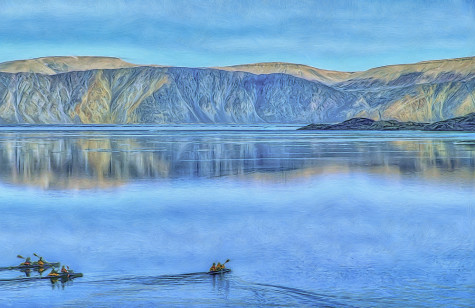On a slushy Ottawa night last week, I tromped into the Officer’s Mess of the Royal Canadian Air Force, here to attend the 513th meeting of the Arctic Circle. When I moved north to Yellowknife ten years ago, my Aunt Diana wrote that her husband Graham would have been pleased I was living in the land he loved so well. He had been an Arctic explorer, as they called northern geographical and archaeological activities in those days. Diana said she had a group of friends who met every month to discuss the Arctic, and she encouraged me to attend if I had the chance.
It turns out her monthly meeting has been taking place since 1947 – almost 70 years! – and features speakers from every discipline relevant to the region. Around 30 people were ranged behind heavy wooden tables and the lecturer, Alexandra Steffen, was here to induct us into the secrets of quicksilver – specifically the methylated form of mercury that causes havoc in growing human brains after bioaccumulating in the marine food chain.
Mercury levels are higher in the air indoors from switches, paints and florescent light bulbs, and they’re high in reservoirs made by recent dams, which dislodge mercury from the soil and create a high-carbon environment primed for methylation. The element is found in cinnabar ore and in the atmosphere at about 1.5 parts-per-billion in the Northern Hemisphere.

But it’s especially found in the Arctic, where it’s delivered in its easily-vaporized elemental form, carried on global air currents. The mercury released in Europe ends up in the Eastern Canadian Arctic, where levels are improving because of stricter European pollution standards. And the mercury released in Asia gets dumped on the Western Canadian Arctic and Alaska. These places are seeing a rising trend.
Some of that is from forest fires and volcanoes, but the majority is anthropogenic, from coal combustion, metal smelting and artisanal gold mining – pools of mercury in a pan with rocks, heated over a fire while bare faces peer down. Korea blames China, China blames India, and Japan blames Korea. India doesn’t believe the models at all. We’ve got a Kyoto Protocol for mercury now – the Minamata Convention of 2013 – and it was signed by 128 countries, but it will only come into force once 50 countries have ratified (we’re at 23 to date).
Twenty years of research in Alert, on gorgeous Ellesmere Island, Nunavut, brought Steffen and her Northern contaminants teammates some genuinely new insights beyond the drudgery of meticulous monitoring. In May, a couple of months after polar sunrise, mercury levels are high in Alert and some unique chemistry occurs.
Steffen and her team began to notice sudden “depletion events”. Over the course of mere hours, atmospheric mercury plummets to nothing at all. Which is to say it gets dumped onto the ground and sea ice. It happens in the same two-week period every year, and the team can now predict when the deposition is going to happen – helpful for knowing when emissions, months before, are going to be most harmful.
The mysterious process centers on a combination of sunlight, ground-level ozone and sea salt in the air, which oxidizes the mercury, transforming it from its elemental form into a more stable form that is less easily vaporized. Climate change will make Arctic sea ice saltier and provide more opportunity for this mercury deposition to happen. In a jolly parting comment, Steffen reminded us that the permafrost is also melting, releasing its stored mercury for recycling into the biosphere.
The meeting adjourned with the promise that next time there would be a historical film shown about eight Labrador Inuit who found themselves imprisoned in a zoo. My own memories of Ellesmere Island newly awakened, I paid my dues and became a member of the Arctic Circle.
Images: Shutterstock — Kayaking on Ellesmere Island fjord, Canadian High Arctic, digital oil painting
— statue of Greek God Mercury, Grand Central Station, New York
